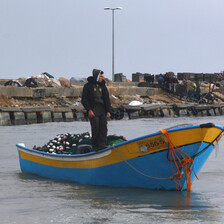The Electronic Intifada Gaza City 9 December 2011

Just 10 percent of Gaza’s 1.6 million residents get water every day.
APA imagesGAZA CITY (IPS) - “Taking our water is not like taking a toy. Water is life, they cannot play with our lives like this,” said Maher Najjar, deputy general director of the Coastal Municipalities Water Utility of the recent Israeli threat to cut electricity, water and infrastructure services to the occupied Gaza Strip.
“Everything will be affected: drinking and washing water, sewage and sanitation, hospitals, schools and children,” said Ahmed al-Amrain, head of power information at the Palestinian Energy and National Resources Authority.
The Israeli Electric Company provides 60 percent of the Strip’s needs, paid by Palestinian customs taxes collected by the Israeli authorities.
Gaza buys 5 percent from Egypt and tries to generate the remaining 35 percent at Gaza’s sole power plant, which was seriously damaged when it was bombed by Israel in 2006.
On 26 November, Israel’s Deputy Foreign Minister Danny Ayalon threatened to cut Israeli electricity, water and ties to Gaza’s infrastructure serving the 1.6 million residents of the Gaza Strip.
True meaning of collective punishment
“This is the true meaning of collective punishment,” said Jaber Wishah from the Palestinian Center for Human Rights. “Children, women, elderly, patients, students, all are subject to this threat.”
Following the 2006 democratic elections which brought Hamas to power, Israel has imposed an increasingly severe siege on the Strip, depriving Palestinians of most essential and basic goods, including livestock, medicines, machinery and replacement parts, and the industrial diesel needed to run the power plant.
Absurd blackmail
“Israel has been steadily cutting electricity and destroying infrastructure over the years, but this is the first time they have explicitly threatened to fully cut everything,” said Wishah. “It is absurd to blackmail the population with their lives because of political issues.”
It is also illegal.
Wishah noted that Israel continues to militarily occupy and control the Gaza Strip, despite the 2005 withdrawal of Israeli settlers and military bases from the Strip.
According to international law, Israel is responsible for the well-being of the Strip’s population, including ensuring electricity, water and a functioning infrastructure.
Under its siege, Israel has since 2007 limited the amount of fuel and industrial diesel allowed to enter Gaza, resulting in daily power outages throughout the Strip, ranging from eight to 12 hours, and interrupting water, sanitation, health and education services.
“Palestinian electricity technicians have asked the Israeli government to repair a main line recently damaged, as has the Israeli Electric Company. But the Israeli government refuses to do so,” said Ahmed al-Amrain.
“The lack of electricity,” he said, “will oblige families to buy diesel for small generators indoors, which can lead to serious accidents and burns.”
More than 100 Palestinians died in 2009 and the first quarter of 2010, Oxfam has reported, from generator-caused fires and carbon monoxide inhalation.
While generators allow some vital machinery to run during power outages, other services, like laundry, are not run on generators. “There is not enough electricity,” said al-Amrain. “They are for emergencies only and are made to run for short periods, not continuously. They are absolutely not an alternative solution for electricity in the Gaza Strip.”
“It will be a complete catastrophe if Israel cuts the electricity. Half of the population would not have access to water,” said Maher Najjar.
Currently 95 percent of the ground water is undrinkable, according to the World Health Organization (WHO). The WHO has detected levels of nitrates, believed to be carcinogenic, higher than 330 milligrams per liter of water, far exceeding the 50 mg/l accepted levels.
“Since 2000 we have had plans to repair and expand water projects in Gaza, but until now only about seven of 100 projects have been completed,” said Najjar.
According to Najjar, just 10 percent of Gaza’s 1.6 million residents get water every day. Another 40 percent get water every two days, 40 percent get water every three days, and 10 percent get water once every four days.
“Israel has drilled over 1,000 wells around the Gaza Strip for their own use. They cut the water flow before it even reaches Gaza,” said Najjar.
While the amount of water supplied by Mekorot, Israel’s national water company, is just 5 percent, it is the threat of Israel cutting electricity and infrastructural needs that most haunts Gaza residents. “Chlorine is vital for our water treatment. Without it, we cannot pump a drop off water,” said Najjar.
Raw sewage
Already, for want of adequate electricity and treatment facilities, up to 80 million liters of raw and partially treated sewage is pumped into sea surrounding Gaza on a daily basis.
In 2008, the World Health Organization reported dangerous levels of fecal bacteria along a third of Gaza’s coast. By 2010, the United Nations agency for Palestine refugees (UNRWA) reported that acute bloody diarrhea and viral hepatitis remained the most serious illnesses among refugees in the Strip.
“We need continuous electricity to pump waste water from homes to sewage treatment plants,” said Najjar. “Generators substitute during power cuts, but without the regular supply of electricity, waste will flood the streets.”
In August 2007, a sewage holding pool in the town of Beit Lahiya overflowed, drowning five residents of a nearby village.
“I think the Israelis are serious with their threat,” said Wishah, “because they don’t pay any attention to the international opinion, nor to international laws and conventions, like the Geneva Conventions, that they’ve signed, which forbid collective punishment. They feel they are above the law and beyond any legal pursuit.”
All rights reserved, IPS - Inter Press Service (2011). Total or partial publication, retransmission or sale forbidden.




